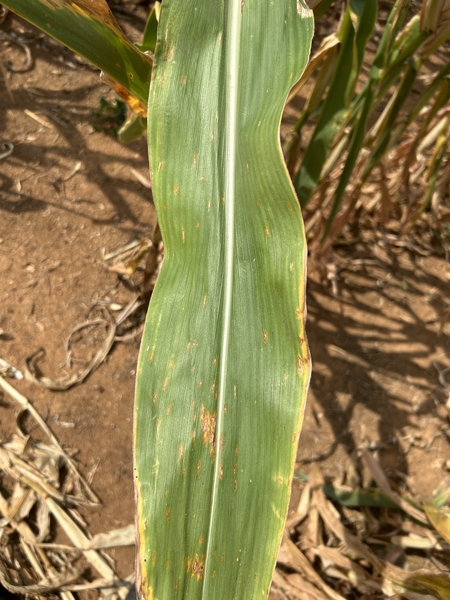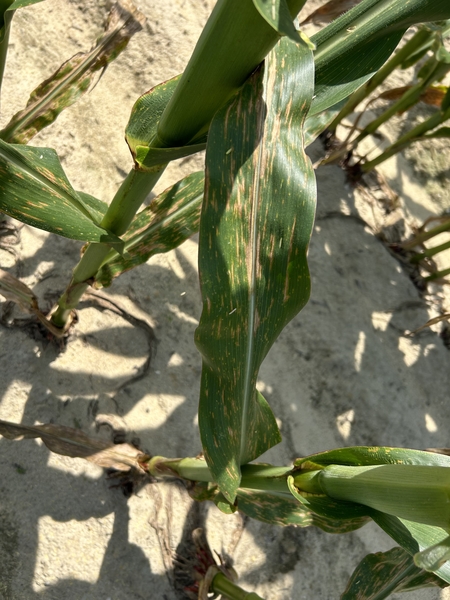Introduction
Gray leaf spot of corn (GLS) is commonly seen in the Mid-Atlantic and Eastern corn belt states where favorable environmental conditions, high heat and humidity, occur annually. GLS is one of the most common foliar diseases in the Piedmont region of North Carolina. The disease rarely impacts corn yields, but may be severe when susceptible hybrids are planted in high risk areas: high disease pressure (inoculum), high humidity, low-lying areas of fields, and no-till/conservation tillage situations.
Pathogen and Disease Cycle
GLS is caused by the ascomycete fungus, Cercospora zeae-maydis.
The fungus survives on crop debris from previous growing seasons. In late spring, when conditions are warm (70-90°F) and humid (≥ 90%), the fungus will produce asexual spores (conidia) that are spread by wind to the lower leaves of growing corn plants. As long as conditions cause leaf wetness for at least 12 hours on infected plants, the fungus will continue to produce spores on the leaf lesions and spread through the wind. At the end of the growing season, the fungus remains in the crop debris sitting on top of or in the soil until susceptible plants and conducive conditions are present.
Symptoms
The lesions (spots) caused by the fungal disease are first found on the lower leaves, but may spread to higher leaves as the disease progresses. The lesions appear as yellow or tan rectangular spots with darkened margins (Figure 1). As lesions mature, they elongate and become more gray in color as spores are produced. Lesions may become several inches long, but are typically limited within the leaf veins. The amount and color of the lesions may vary among different hybrids.
In early stages, several foliar diseases on corn may look similar to GLS:
Anthracnose leaf blight (Colletotrichum graminicola)
- Early lesions are water-soaked and oval, but expand to irregular shapes.
Bacterial leaf streak (Xanthomonas vasicola)
-
This pathogen is not currently found in North Carolina, but may be transported here on infected plant materials. This pathogen produces rectangular lesions with a distinct yellow halo around the lesion when held up to the sun. Lesions are also devoid of fungal spores. Should bacterial leaf streak be suspected, contact local extension for assistance in identification.
Common rust (Puccinia sorghi)
- Early common rust lesions may produce small yellow lesions,but will form orange to brown pustules.
Curvularia leaf spot (Curvularia lunata) and Eyespot of Corn (Aureobasidium zeae)
-
Lesions are small and round with darkened margins and produce a characteristic halo around the lesions. Unlike GLS, the lesions do not elongate.
Northern corn leaf blight (Exserohilum turcicum)
-
The lesions of this disease will appear as yellow or tan rectangular spots, but will expand into large cigar-shaped lesions that are not limited by veins.
Southern corn leaf blight (Bipolaris maydis)
-
The lesions of this disease will appear as yellow or tan rectangular spots, but will not develop darkened margins.
Management
Crop Debris Destruction
-
Destroy all stalks and other debris from fields, as soon after harvest as possible. Till debris as deep into the soil as possible, while managing soil erosion.
-
Burning is not an effective control method as it only removes the debris on the surface. If burning is used to remove excess debris, it should be combined with tillage to push debris to deeper levels of soil.
Crop Rotation
-
The GLS fungus is limited to corn, so crop rotation with any other crop is effective at reducing disease pressure.
-
The longer the crop rotation, the more beneficial the rotation is at lowering the disease pressure.
-
A 3 year crop rotation is more beneficial than a 2 year rotation, though a 2 year rotation is more beneficial than no rotation.
-
Resistant Varieties
-
Several hybrids are available with partial resistance to GLS. Ask your seed supplier for these hybrids.
Plant Health and Scouting
-
Reduce drought stress through irrigation.
-
Reduce nutrient stress through proper fertilization.
-
Scout for GLS on the lower leaves prior to VT (tasseling).
Chemical Control
-
Fungicide applications may be valuable to protect yield when applied between VT and R2.
-
For fungicide efficacy ratings, see the efficacy table on the NC State Corn extension portal.
Useful Resources
- The NC State University Plant Disease and Insect Clinic provides diagnostics and control recommendations
- The NC State Extension Plant Pathology portal provides information on crop disease management
- The North Carolina Agricultural Chemicals Manual provides pesticide information for common diseases of North Carolina. The manual recommendations do not replace those described on the pesticide label, and the label must be followed.
- The Crop Protection Network factsheet for gray leaf spot provides other resources for ID and management.
Publication date: Sept. 30, 2020
Reviewed/Revised: Sept. 28, 2023
N.C. Cooperative Extension prohibits discrimination and harassment regardless of age, color, disability, family and marital status, gender identity, national origin, political beliefs, race, religion, sex (including pregnancy), sexual orientation and veteran status.
NC Cooperative Extension prohíbe la discriminación por raza, color, nacionalidad, edad, sexo (incluyendo el embarazo), discapacidad, religión, orientación sexual, identidad de género, información genética, afiliación política, y estatus de veteran.
Recommendations for the use of agricultural chemicals are included in this publication as a convenience to the reader. The use of brand names and any mention or listing of commercial products or services in this publication does not imply endorsement by NC State University or N.C. A&T State University nor discrimination against similar products or services not mentioned. Individuals who use agricultural chemicals are responsible for ensuring that the intended use complies with current regulations and conforms to the product label. Be sure to obtain current information about usage regulations and examine a current product label before applying any chemical. For assistance, contact your local N.C. Cooperative Extension county center.
N.C. Cooperative Extension prohibits discrimination and harassment regardless of age, color, disability, family and marital status, gender identity, national origin, political beliefs, race, religion, sex (including pregnancy), sexual orientation and veteran status.


